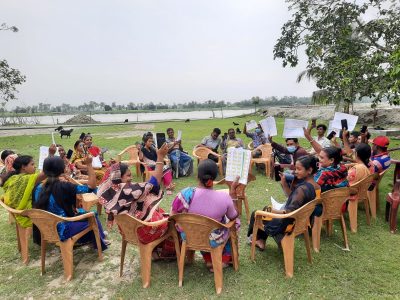Like many other areas in the global South, Bangladesh has a large number of people who depend on small-scale agriculture for their livelihood as well as food security. Global climate change threatens both of these aspects. Spyros Paparrizos discusses below evidence for a practical, technology-based solution that can bring together efforts by the government, businesses and end-users in the creation and delivery of Climate Information Services (CIS) in a holistic way, allowing smallholders to gain greater control in the face of a changing climate.
Many developing areas in the global South offer ideal conditions for farmers involved in small-scale agriculture due to their agro-ecological value and good access to markets.
Bangladesh is no exception as it features the world’s largest river delta which is formed by the Ganges, the Brahmaputra and the Meghna rivers. This forms an ecologically rich and highly productive agricultural zone. Two out of every three Bangladeshis – about 110 million people – live within this delta and depend on it for their lives and livelihoods.

Source: Courtesy WATERAPPs Project
While planning for farming activities in these regions (e.g., choice of crops, planting date, irrigation, pesticide and fertiliser application, etc.), climate is a key driver. Yet, climate is changing and this significantly impacts agro-ecosystems around the globe.
Increased hydro-climatic variability as a result of climate change threatens food security and the well-being of smallholder farming communities.
These are exposed to extreme weather conditions resulting in crop failure, pest and disease outbreak.
For example, during the super cyclone Amphan in May 2020, southwest Bangladesh experienced great damages in infrastructure, including to river embankments, due to heavy storm surge and tidal water pressure in the region. Information to smallholder farmer arrived very late, giving them almost no time to prepare themselves and secure their livelihoods. The cyclone uprooted countless trees and left chaos in its wake. The super cyclone destroyed cultivations, storage facilities and left thousands of people homeless in the affected areas. Many people were supposed to evacuate their homes; however, they decided not to join the cyclone shelters due to the COVID-19 pandemic which worsened the situation. The aftermath of Amphan left agricultural lands and aquaculture farms flooded and underwater. Until today, this has been having an impact on the livelihoods of the inhabitants of coastal Bangladesh.
As Amphan showed us, for smallholder farmers, the impacts of climate change directly affects both their household income and livelihood sustainability. Extreme weather events without adequate time to prepare result in great economical loses on farm level.
What do Climate Information Services have to offer?
Although adaptation to climate change is above all a matter of governance, recent technological advancements and the rapid increase of information technology offer high potential.
Amongst technological options, climate information services (CIS) as an adaptation option can offset climate change impacts and build resilient and sustainable farming systems in farming communities of Bangladesh and in the global South in general.
The WATERAPPs project, led by Wageningen University was initiated in 2016 with the aim to co-develop participatory climate information services with and for smallholder farmers in the rapidly urbanising Lower Ganges Delta of Bangladesh. It aimed to improve the resilience and adaptive capacity of smallholder farmers and contribute to actionable knowledge for sustainable agriculture.
Wageningen University researchers engaged on the field with smallholder farmers, agricultural extension officers (DAE) and other key players in the agri-food-weather chain. Farmer Field Schools (FFS) were initiated in which farmers co-designed and co-developed CIS while building their adaptive capacity to manage farm activities at the same time.

A Session at a Farmer Field School, courtesy WATERAPPs Project
During the process, researchers were engaged with FFS participants on a weekly basis through the main cropping season in Bangladesh (mid-May to mid-October) through face-to-face interactions. These interactions included general explanation around the weekly-provided forecast information, group discussion on forecasts to enhance uptake, and translating forecast into agricultural advisory services and farm decision-making.
By the end of the cropping season and the field engagement, several things became clear during the evaluation phase: farmers are very eager to receive weather and climate information to cope with and improve their farm decision-making. Their efforts are targeted – besides securing their own livelihoods – towards increasing their economic output and find their way to the market.
At the moment, however, existing services lack location-specific, timely, understandable and skilful information and follow a top-down approach that prevents them from being optimally useful. For example, communication channels such as local media (television, radio) offer generalised information and on top of that in many cases information does not reach them.
Co-producing participatory services through a bottom-up approach enabled effective communication and ensured that the services are designed and tailored to the needs of the end-users.
This included information on 7- and 14-day weather forecast as well as seasonal (up to 3 months) information.
Are farmers willing to pay for climate services?
Following the end of the cropping season, an assessment of the farmers’ willingness to pay (WTP) for participatory services was conducted, that considered various motivational and socio-economic factors. This included factors such as previous exposure to CIS, gender, age, education, family and farm size. To account for the participatory component and its influence, the study included also a control group who had no prior exposure to CIS nor participated in the study.
Results indicated that more than 90% of the farmers who had received prior training and taken part in the co-development process expressed a willingness to pay for tailor-made CIS, compared to some 75% for the control group. The main driving factors for WTP were the cost of the service, followed by whether or not the farmers had received prior training and capacity-building in climate and weather-related phenomena.
The monetary amount farmers were willing to pay for CIS subscriptions ranged from 970.92 taka (US $11.45) to 1387.20 taka ($16.36) annually. Given that Bangladesh has more than 17 million farm households, this suggests a huge market size for CIS, if similar willingness to pay for such services exists throughout the country.
Way forward
One thing that became evident during the process was that a user-pay model should be avoided. Instead, a revenue model where a third party absorbs cost to the end-user is most promising.
In addition to the high percentage of farmers that are willing to pay for participatory CIS, the involved extension service officers expressed keen interest in scaling up the FFS activities and in offering the climate and weather-related training more widely.
These findings indicate that the time may be ripe for social entrepreneurs and private sector participants to emerge as CIS providers in Bangladesh.
With co-development of CIS, and fine-tuning of CIS to users’ needs, there may now be an opportunity to implement tailor-made climate- and weather-information services to play a vital role in mitigating the risks associated with farming activities, while enhancing the climate resilience of Bangladesh’s agricultural sector.
Governmental organisations, such as the Department of Agricultural Extension (DAE) and the Bangladesh Meteorological Department (BMD), can play a key role in this regard, particularly by investing in programmes to build the capacity of farmers and provide, help interpret, and use climate and weather information in their on-farm activities. To hasten the commercial development of CIS, private players or social entrepreneurs could be subsidised for a period of time, to assist in creating a viable market for CIS and stimulate private investment in tailor-made climate- and weather-information services.
Climate Information Services could play a pivotal role in enhancing the climate resilience of Bangladesh’s agricultural sector and unlock its agriculture potential in a world faced with global change.
See more at: – Her story – co-designing climate information services in Bangladesh (YouTube video); – WATERAPPs, an innovation in agriculture and strategic delta planning (YouTube video)
Banner Image: © WATERAPPs Project
The views expressed here are those of the author and not of the ‘South Asia @ LSE’ blog, the LSE South Asia Centre, or the London School of Economics and Political Science.







